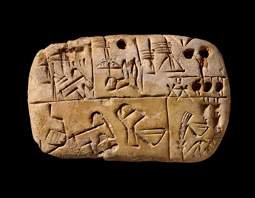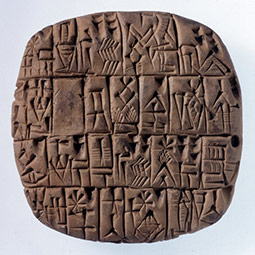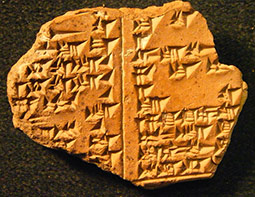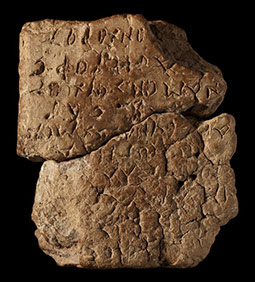The Sumerian language
Sumerian is the earliest documented language in Mesopotamia, and perhaps the world. Long after it ceased to be spoken as a mother tongue, knowledge of it continued to be maintained as a prestigious part of Mesopotamian scholarship until the death of cuneiform writing some two thousand years later.

Image 1: Clay tablet inscribed with details of food rations, dating from c.3300-3100 BC from southern Mesopotamia. Note the pictorial nature of the signs, such as the human head with bread in the lower register, typical of ration texts. The sign is used in later Sumerian to mean "eat". The round indentations record numbers. BM 140852. View large image on British Museum website. © The Trustees of the British Museum.
Sumerian emerged as a written language in what is now southern Iraq at the end of the 4th millennium BC. It therefore vies with Egyptian for the title of the oldest recorded language in the world. The word "Sumerian" derives from the Akkadian TT word šumeru; the Sumerians themselves referred to their language simply as eme-gi7 ("native tongue"). Sumerian was written on clay tablets TT and other durable materials such as stone using the cuneiform script. Many of the earliest signs were pictorial in nature (Image 1) but they gradually developed more stylised and linear forms (Image 2). The script itself functioned as a mixture of logograms, which represent whole words, and phonetic signs, which represent vowels and syllables. Impressed signs were also used to record numbers in a variety of different arithmetical bases.
"A scribe who does not know Sumerian, what (kind of) a scribe is he?"
Eventually, the cuneiform script which had been developed for Sumerian was adapted for Akkadian, a Semitic language TT also spoken in Mesopotamia but linguistically unrelated to Sumerian. The two languages were used side by side until Sumerian died out as a mother tongue, sometime around 2000 BC (the exact date remains the subject of much debate). However, this did not spell the end of Sumerian. Its influence on Akkadian remained visible in Sumerian loanwords and certain grammatical features as well as in the logograms (or "Sumerograms") which had originated as Sumerian cuneiform signs. This was especially true in the Neo-Assyrian TT period, when the use of logograms as opposed to syllabic writings became a particularly popular way of showcasing one's learnedness and appreciation of cuneiform's complexity.

Image 2: Clay tablet inscribed in Sumerian, c.2500 BC, showing a more linear form of the cuneiform script. The inscription gives an account of silver TT and other commodities and is probably from the Sumerian city of Šuruppag PGP . BM 15826. View large image on British Museum website. © The Trustees of the British Museum.
Even more importantly, such was the perceived importance and prestige of Sumerian that it continued to be maintained as a language of cult and scholarship, much like Latin in medieval Europe. An old Sumerian proverb asks, "A scribe TT who does not know Sumerian, what (kind of) a scribe is he?" (ETCSL 6.1.02 80), and this continued to hold true in first millennium Assyria. Scribal training remained bilingual, but scribes who grew up speaking the Assyrian dialect of Akkadian now had to acquire Sumerian as a second language. To do so, they relied on many of the same sorts of resources that we still use in language learning today, from lexical lists TT and grammars to bilingual texts.
In fact, we owe our ability to understand Sumerian to these ancient learning tools, as they have provided Assyriologists TT with an invaluable means of deciphering the language through the much better understood Akkadian. Without these texts, our ability to appreciate the rich Sumerian-language culture would be greatly diminished, although the language itself continues to present significant challenges in terms of both grammar and vocabulary.
Keeping Sumerian alive in the first millennium BC

Image 3: As well as lists of Sumerian words with their Akkadian translations, scribes also kept lists of Akkadian synonyms. This fragment of a tablet from Nimrud contains an extract from the Akkadian list Malku = Šarru, including alternative words for "please". CTN 4: 218. British Museum ND 5434. View large image (212 KB).
By the first millennium BC, compositions only in Sumerian had become fairly rare, probably reflecting the crucial role which Akkadian played in providing access to Sumerian. Such monolingual texts tend to record incantations TT used in religious rituals TT . Much more common were bilingual compositions featuring both languages, whether in separate columns or with the Akkadian translation inserted into the body of the Sumerian text to provide a line-by-line translation (see Image 3).
Most of the Sumerian texts from the Neo-Assyrian period come from the cities of Assur PGP , the religious capital of Assyria, and from Nineveh PGP , the site of the famous library of king Assurbanipal PGP . Excavations in the city of Kalhu have also uncovered numerous bilingual tablets which were once housed in Ezida, the city's temple to the god Nabu. Bilingual tablets including literary compositions and cultic texts have also been found in the tiny town of Huzirina in Anatolia PGP , far away from the Assyrian heartland, demonstrating the wide spread of Mesopotamian scribal culture.
In Kalhu itself, Sumerian featured in the scholarly works kept in Nabu's temple.The included Sumerian and bilingual prayers and incantations, cultic hymns, and lexical lists, as well as literary compositions about the hero god Ninurta.
Beyond cuneiform: Sumerian and the Hellenistic world

Image 4: The reverse TT of a tablet from the so-called Graeco-Babyloniaca, showing a rendering into the Greek alphabet of an incantation against evil spirits which is written in Sumerian and Akkadian cuneiform on the tablet's obverse; probably from Babylon, dating from the last few centuries BC. BM 34816. View large image on British Museum website. © The Trustees of the British Museum.
Knowledge of Akkadian and Sumerian survived the demise of Assyria at the end of the 7th century BC, as well as that of Assyria's successor, the Neo-Babylonian TT empire. Even after the Mesopotamian lands were absorbed into empires ruled by foreign-born kings, the Sumero-Babylonian scribal tradition lived on. A group of remarkable documents, known as the Graeco-Babyloniaca and dating mainly between the 1st centuries BC and AD, shows evidence of the transmission of Sumerian and Akkadian to Greek-speaking trainee scribes (or possibly attempts to write those languages using the alphabetic rather than cuneiform script). Sumerian and Akkadian text was written out in cuneiform on one side and transliterated into Greek characters on the other (see Image 4). The result is a fascinating insight into the longevity and continued appeal of Mesopotamian knowledge.
For an overview of Sumerian grammar, see the Electronic Text Corpus of Sumerian Literature.
Content last modified: 18 Dec 2019
Further reading
- Black, J.A., 2007. "Sumerian", in J.N. Postgate (ed.), Languages of Iraq, Ancient and Modern, London: British School of Archaeology in Iraq, pp.4-30.
- Fincke, J.C., 2003/2004. "The Babylonian texts of Nineveh: report on the British Museum's Assurbanipal Library Project", Archiv für Orientforschung 50, pp. 111-149 (free PDF from Knowledge and Power, 5.5 MB).
- Geller, M.J., 1997. "The last wedge", Zeitschrift für Assyriologie und Vorderasiatische Archäologie 87, pp. 43-95.
- Michalowski, P., 2004. "Sumerian", in R.D. Woodard (ed.), The Cambridge Encyclopedia of the World's Ancient Languages, Cambridge: Cambridge University Press, pp. 19-59.
- Westenholz, A., 2007. "The Graeco-Babyloniaca Once Again", Zeitschrift für Assyriologie und Vorderasiatische Archäologie 97, pp. 262-313.
Silvie Zamazalová
Silvie Zamazalová, 'The Sumerian language', Nimrud: Materialities of Assyrian Knowledge Production, The Nimrud Project at Oracc.org, 2019 [http://oracc.museum.upenn.edu/nimrud/ancientkalhu/thewritings/sumerian/]